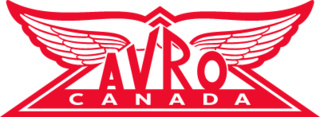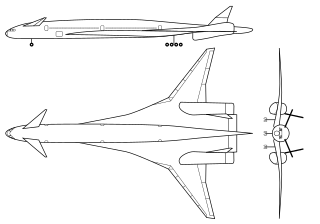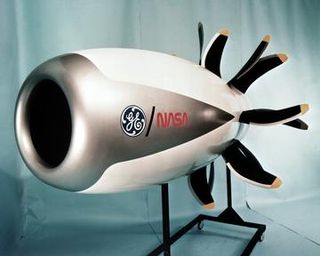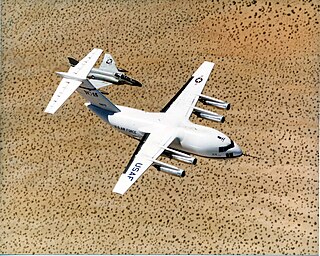
Avro Canada was a Canadian aircraft manufacturing company. It started in 1945 as an aircraft plant and within thirteen years became the third-largest company in Canada, one of the largest 100 companies in the world, and directly employing over 50,000. Avro Canada was best known for the highly advanced CF-105 Arrow, but through growth and acquisition, it rapidly became a major, integrated company that had diverse holdings.
McDonnell Douglas was a major American aerospace manufacturing corporation and defense contractor formed by the merger of McDonnell Aircraft and the Douglas Aircraft Company in 1967. Between then and its own merger with Boeing in 1997, it produced a number of well-known commercial and military aircraft such as the DC-10 airliner and F-15 Eagle air-superiority fighter.

The Douglas DC-8 is an American four-engine mid- to long-range narrow-body jet airliner built from 1958 to 1972 by the Douglas Aircraft Company. Launched after the competing Boeing 707, the DC-8 nevertheless kept Douglas in a strong position in the airliner market, and remained in production until 1972 when it began to be superseded by larger wide-body designs, including the Boeing 747, McDonnell Douglas DC-10, and Lockheed L-1011 TriStar. The DC-8's design allowed it a slightly larger cargo capacity than the 707 and some re-engined DC-8s are still in use as freighters.

A supersonic transport (SST) is a civilian supersonic aircraft designed to transport passengers at speeds greater than the speed of sound. To date, the only SSTs to see regular service have been Concorde and the Tupolev Tu-144. The last passenger flight of the Tu-144 was in June 1978 and it was last flown in 1999 by NASA. Concorde's last commercial flight was in October 2003, with a November 26, 2003 ferry flight being its last airborne operation. Following the permanent cessation of flying by Concorde, there are no remaining SSTs in commercial service. Several companies have each proposed a supersonic business jet, which may bring supersonic transport back again.

The Convair 990 Coronado is an American narrow-body four-engined jet airliner produced by the Convair division of General Dynamics, a stretched version of their earlier Convair 880 produced in response to a request from American Airlines. The 990 was lengthened by 10 ft (3.0 m), which increased the number of passengers from between 88 and 110 in the 880 to between 96 and 121 in the 990. This was still fewer passengers than the contemporary Boeing 707 or Douglas DC-8, although the 990 was 25–35 mph (40–56 km/h) faster than either in cruise.

The McDonnell Douglas MD-11 is an American three-engine medium- to long-range wide-body jet airliner, manufactured by McDonnell Douglas and, later, by Boeing Commercial Airplanes. Based on the DC-10, it features a stretched fuselage, increased wingspan with winglets, refined airfoils on the wing and smaller tailplane, new engines and increased use of composite materials. Two of its engines are mounted on underwing pylons and a third engine at the base of the vertical stabilizer. It also features a glass cockpit that decreases the flight deck crew to two from the three required on the DC-10 by eliminating the need for a flight engineer.

The Boeing Sonic Cruiser was a concept jet airliner with a delta wing-canard configuration. It was distinguished from conventional airliners by its delta wing and high-subsonic cruising speed of up to Mach 0.98. Boeing first proposed it in 2001, but airlines generally preferred lower operating costs over higher speed. Boeing ended the Sonic Cruiser project in December 2002 and shifted to the slower, but more fuel-efficient 7E7 airliner.

The Lockheed Martin X-33 was an unmanned, sub-scale technology demonstrator suborbital spaceplane developed in the 1990s under the U.S. government-funded Space Launch Initiative program. The X-33 was a technology demonstrator for the VentureStar orbital spaceplane, which was planned to be a next-generation, commercially operated reusable launch vehicle. The X-33 would flight-test a range of technologies that NASA believed it needed for single-stage-to-orbit reusable launch vehicles, such as metallic thermal protection systems, composite cryogenic fuel tanks for liquid hydrogen, the aerospike engine, autonomous (unmanned) flight control, rapid flight turn-around times through streamlined operations, and its lifting body aerodynamics.

A propfan, also called an open rotor engine, unducted fan, or ultra high-bypass turbofan, is a type of aircraft engine related in concept to both the turboprop and turbofan, but distinct from both. The design is intended to offer the speed and performance of a turbofan, with the fuel economy of a turboprop. A propfan is typically designed with a large number of short, highly twisted blades, similar to a turbofan's bypass compressor. For this reason, the propfan has been variously described as an "unducted fan" or an "ultra-high-bypass (UHB) turbofan."

The Boeing YC-14 was a twin-engine short take-off and landing (STOL) tactical military transport aircraft. It was Boeing's entrant into the United States Air Force's Advanced Medium STOL Transport (AMST) competition, which aimed to replace the Lockheed C-130 Hercules as the USAF's standard STOL tactical transport. Although both the YC-14 and the competing McDonnell Douglas YC-15 were successful, neither aircraft entered production. The AMST project was ended in 1979 and replaced by the C-X program.

The McDonnell Douglas YC-15 was a prototype four-engine short take-off and landing (STOL) tactical transport. It was McDonnell Douglas' entrant into the United States Air Force's Advanced Medium STOL Transport (AMST) competition to replace the Lockheed C-130 Hercules as the USAF's standard STOL tactical transport. In the end, neither the YC-15 nor the Boeing YC-14 was ordered into production, although the YC-15's basic design would be used to form the successful McDonnell Douglas C-17 Globemaster III.

The McDonnell Douglas MD-12 was an aircraft design study undertaken by the McDonnell Douglas company in the 1990s for a "superjumbo" aircraft, first conceived as a trijet larger than the MD-11, then stretched to a quadjet airliner. It was to be similar in size to the Boeing 747, but with greater passenger capacity. However, the MD-12 received no orders and was canceled. McDonnell Douglas then studied larger MD-11 derivatives named MD-XX without proceeding.

The Rockwell X-30 was an advanced technology demonstrator project for the National Aero-Space Plane (NASP), part of a United States project to create a single-stage-to-orbit (SSTO) spacecraft and passenger spaceliner. It was cancelled in the early 1990s before a prototype was completed, although much development work in advanced materials and aerospace design was completed. While a goal of a future NASP was a passenger liner capable of two-hour flights from Washington to Tokyo, the X-30 was planned for a crew of two and oriented towards testing.

The General Dynamics F-16XL is a derivative of the F-16 Fighting Falcon, with a cranked-arrow delta wing. It was originally conceived as a technology demonstrator, later entered in the United States Air Force's (USAF) Enhanced Tactical Fighter (ETF) competition but lost to the F-15E Strike Eagle. Several years after the prototypes were shelved, they were turned over to NASA for additional aeronautical research. Both aircraft are currently stored at Edwards AFB.

A supersonic aircraft is an aircraft able to fly faster than the speed of sound. Supersonic aircraft were developed in the second half of the twentieth century and have been used almost entirely for research and military purposes. Only two, Concorde and the Tupolev Tu-144, ever entered service for civil use as airliners. Fighter jets are the most common example of supersonic aircraft.

The McDonnell Douglas F-15 STOL/MTD is a modified F-15 Eagle. Developed as a technology demonstrator, the F-15 STOL/MTD carried out research for studying the effects of thrust vectoring and enhanced maneuverability. The aircraft used for the project was pre-production TF-15A (F-15B) No. 1, the first two-seat F-15 Eagle built by McDonnell Douglas, the sixth F-15 off the assembly line, and was the oldest F-15 flying up to its retirement. It was also used as the avionics testbed for the F-15E Strike Eagle program. The plane was on loan to NASA from the United States Air Force.
The Fokker F29 was a conceptual jet airliner design by the Dutch aircraft manufacturer, Fokker.
Douglas Aircraft Company's Model 2229 was a proposed supersonic transport (SST) originally started as a private study. The design progressed as far as making mock-ups of the cockpit area and wind-tunnel models of the overall layout. After studying the design, Douglas concluded that the SST would not work economically, and declined to enter the Model 2229 in the National Supersonic Transport (NST) program in 1963.

















